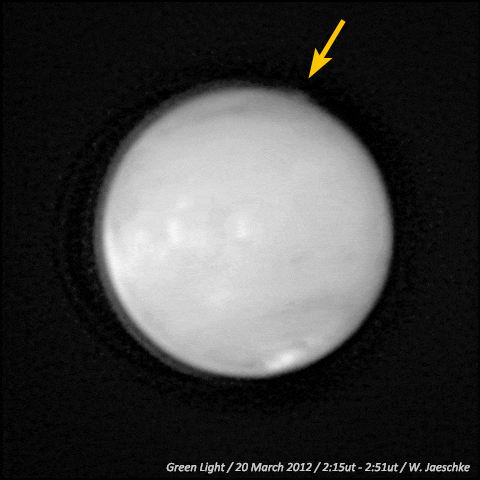Just stumbled upon this amazing high resolution image of Mars.
Is there a thin atmosphere around this planet?

HD link: MarsHD
Just stumbled upon this amazing high resolution image of Mars.
Is there a thin atmosphere around this planet?

HD link: MarsHD
If my memory is Ok, it has two satellites, Demos and Phobos (fear) and (terror), they are both on equatorial orbits of Mars and one goes clockwise and ‘tother anti clockwise.
Aquila said:
Just stumbled upon this amazing high resolution image of Mars.
Is there a thin atmosphere around this planet?
HD link: MarsHD
Yes..
There is also a very thin atmosphere around the planet earth.
That image is amazing, the way that surface of Mars is angled to the Sun (light) and shows both the atmosphere and surface detail of the planet.
This might as well go in here:
Mystery Mars haze baffles scientists

A mysterious haze high above Mars has left scientists scratching their heads.
The vast plume was initially spotted by amateur astronomers in 2012, and appeared twice before vanishing.
Scientists have now analysed the images and say that say the formation, stretching for more than 1,000km, is larger than any seen before.
Writing in the journal Nature, the researchers believe the plume could be a large cloud or an exceptionally bright aurora.
However, they are unsure how these could have formed in the thin upper reaches of the Martian atmosphere.
Full: http://www.bbc.com/news/science-environment-31491805
Don’t you need a magnetic field for there to be an aurora? I thought that Mars’ magnetic field was defunct…
furious said:
- or an exceptionally bright aurora
Don’t you need a magnetic field for there to be an aurora? I thought that Mars’ magnetic field was defunct…
You’d need one for it to be concentrated at the “poles”…. I guess because the martian atmosphere is so tenuous, you’d get aurora more easily though .. i guess if that bit of the atmosphere is in the path of a shower of charged particles, then you’d get one
bloody job seeker networks..
they’ll be the first up against the wall when I get into power…
stumpy_seahorse said:
bloody job seeker networks..they’ll be the first up against the wall when I get into power…
Bloody martians.. coming here and takin our jobs..
You don’t necessarily need an external planetary magnetic field for aurorae (a crustal field will do):
Mars Express discovers aurorae on Mars
First aurora ever detected on Mars
9 June 2005 ESA’s Mars Express spacecraft has for the first time ever detected an aurora on Mars. This aurora is of a type never before seen in the Solar System.
Observations by the SPICAM instrument (Spectroscopy for the Investigations and the Characteristics of the Atmosphere on Mars) made on 11 August 2004, revealed light emissions now interpreted as an aurora.
Aurorae are spectacular displays often seen at the highest latitudes on Earth. On our planet, as well as on the giant planets Jupiter, Saturn, Uranus and Neptune, they occur at the foot of the planetary magnetic field lines near the poles, and are produced by charged particles – electrons, protons or ions – precipitating along these lines.
Aurorae have also been observed on the night side of Venus, a planet with no intrinsic (planetary) magnetic field. Unlike Earth and the giant planets, Venusian aurorae appear as bright and diffuse patches of varying shape and intensity, sometimes distributed across the full planetary disc. Venusian aurorae are produced by the impact of electrons originating from the solar wind and precipitating in the night-side atmosphere.
Like Venus, Mars is a planet with no intrinsic magnetic field. A few years ago it was suggested that auroral phenomena could exist on Mars too. This hypothesis was reinforced by the recent Mars Global Surveyor discovery of crustal magnetic anomalies, most likely the remnants of an old planetary magnetic field.
SPICAM detected light emissions in the southern hemisphere on Mars, during night-time observations in the region corresponding to 177º East and 52º South. The total size of the emission region is about 30 km across, possibly about 8 km high.
While the detected emission is typical for daytime, it must indicate the excitation of the upper atmosphere by fluxes of charged particles – probably electrons – if observed during night-time.
http://www.esa.int/Our_Activities/Space_Science/Mars_Express/Mars_Express_discovers_aurorae_on_Mars
bob(from black rock) said:
…one goes clockwise and ‘tother anti clockwise.
I don’t think that’s quite right. Both are tidally locked to Mars, and both orbit in the same direction.
Unlike our Moon which takes about a month to orbit the Earth, Phobos’ time to complete one orbit is less than one Martian day, so it rises in the “west” and sets in the “east”. In other words, it out-races the rotation of the planet. Deimos orbit, on the other hand, is completed in just over one day so it rises in the East, moves very slowly across the sky and sets in the West.